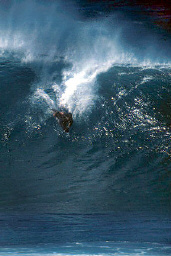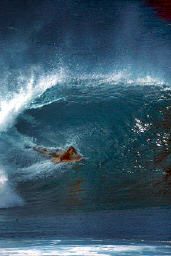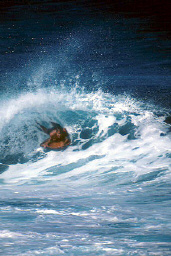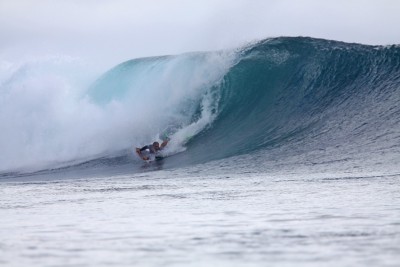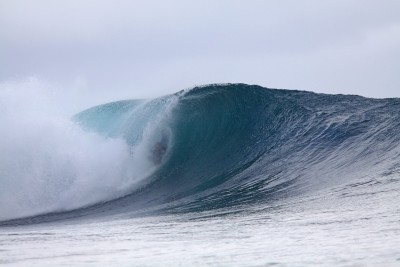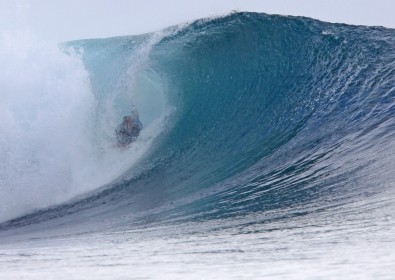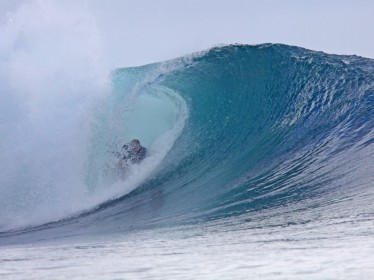Sean Ross Paipo Interview
November 9, 2009. Honolulu, Hawaii
Questions from Bob Green
Interview by John Clark
Photographs courtesy of Sean Ross unless otherwise noted
1.
There are some classic photos of you completely on the rail surfing
Pipeline. I'd like to hear more about surfing Pipeline, but
first, what attracted you to paipo boards? Were there early influences
or did you have to figure it out yourself?
I
was the youngest of four kids, and we all grew up swimming
competitively for Coach Soichi Sakamoto of Hawaii Swim Club. We
began surfing Waikiki in the early sixties, and the Waikiki Beach
Center was our hangout. My parents would drop us off in the morning and
pick us up in evenings. We surfed all day at Canoes and Queens. My
brothers were hard chargers and moved on to Ala Moana where Conrad
Canha, Buzzy Kneubuhl, and lots of old timers whose names escape me
were surfing. I went with them, and I was teased for being the
"buoy." I weighed 60 pounds, and with a 9'6" Velzy Jacobs I was
not the picture of a hard charging grom. A three foot wave would
back me up 30 feet, I'd paddle and gain 10, then I'd get washed back 30
feet again.
My sister's boyfriend, Bob Lindbergh, gave me a paipo, which was
basically half a surfboard with a skeg. But that was my
start. At least I was able to make it out and catch waves. It was probably 1965, and I was 10. When I was about 13, I was
introduced to a Paipo Nui by my oldest brother's friend and classmate,
Mark Zumwinkle. Mark was a million years ahead of his time. While most
paipo riders were riding with one arm straight out, and I still haven't
figured out why they did that, Mark was studying George Greenough and
making hard bottom turns, off the lips, and roller coasters. He
was probably my main influence as a paipo boarder.
2.
Were there many other guys riding paipo when you started? If so, who stood out?
During
the 1960s, there were still a lot of guys riding paipos, but none of
their styles interested me. Mercer Aikala liked to kneel. The
Richards brothers, Primo and Royal, stood up, and they were definitely
hot, but I was into the more radical maneuvres that were being
innovated during the 60s. I wanted to do a BK [Barry Kanaiaupuni] hard
bottom turn and punch through the lip. I wanted to do a roundhouse
like Billy Hamilton. I wanted to do manuevers like George Greenough,
Jock Sutherland, Nat Young, and Wayne Lynch, but how do you do those
things on a paipo? Most of them I never figured out.
|
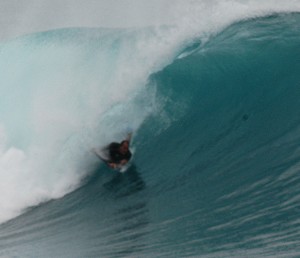
Mentawais - October 2006
Photo by: Rob Morris, owner of
the vessel "Nusantara"
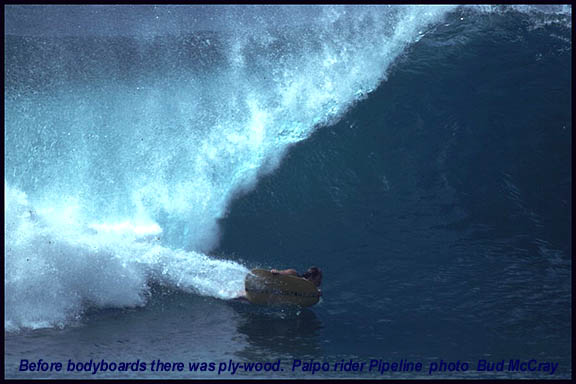 Paipo rider named Sean Ross having fun at the
Paipo rider named Sean Ross having fun at the
Pipeline. He is riding one of Paul Lindbergh's
Hawaii Paipo Designs boards. Sean was a life
guard at the Ehukai Beach (Pipeline) for years
in the 1970's.
Photo: Alan McCray, Hawaii.
|
3. What was your first paipo board like and who made it?
Mark
Zumwinkle sold me my first Paipo Nui for $15. The problem was they
were laminated together with wood glue, and as the wood would try to
flex back to flat, they would delaminate. They were made of three
layers of 1/16th marine mahogany veneer, or ply, by Val Valentine. I am
not sure where he got his original template, as I only remember him as
a surf movie guy. The summer of '69 I bought a brand new one from him,
a swallow tail with a heavy concave. It turned real nice, but the
concave killed the speed. It was a real dog.
Val also made a foam Paipo Nui. I believe it was blown foam, and if it
got dinged, it would get waterlogged and die. And it was way to
buoyant. When you are turning hard at Pipe, your rail becomes your
skeg. The foam boards tended to lose their edge and side-slip, which
means death at Pipe, so I rejected them.
Bob Lindbergh's younger brother Paul made a mold similar to a Paipo Nui in
Mr. Murakami's wood shop at Roosevelt High School. I made a lot of
boards
off that mold. To eliminate the delamination, I used only two pieces of
marine ply and laminated them with a mat, roven. I would cut out the
wood in the center, all the way to the tail, imitating Greenough. They
worked great, but had very little flotation and were frequently lost on
big days. Eventually, Paul Lindbergh began making paipos commercially,
and we have finally got the boards where I like them. They are
vacuum-bagged, high density sheet foam, thinned out in the center so I
get the flex I need for hard bottom turns. A carbon fiber stiffener
runs fore and aft, keeping the board rigid so you don't lose speed.
Check out his site at Paipo.com.
I experimented with fins once. I made them too big, and I couldn't get
them to break free while I was riding. I tried them at Maalaea on an
epic day, and I ended up on the breakwall, breaking them off on the
rocks. I still think that small disc type fins would help with
side-slipping.
4.
I have heard it was difficult making the drop on a paipo out at
Pipeline. What was it like riding big hollow waves such as Pipeline on
a paipo? Did you have to adopt a different approach to riding paipo at
Pipeline? How about those turns where the board appears to be barely in
the water, can you tell me a bit more about those turns? Any special
techniques or tips you could pass on?
I
started riding at Pipe in 1972, and I learned right away that it was
hard to make the drop, make the turn, and get out into the flats. The
challenge was that I didn't have the projection with a paipo board when
I made the drop. I learned that I had to have a tremendous amount of
speed when I took off and that I had to have my angle set. I learned
how to position myself so that I was exactly at the perfect place when
I took off. Once I figured it all out, making the drop at Pipe was
easy. The waves there break on a shallow reef close to shore, so the
faces and the barrels are almost always smooth, which made it easy,
too, for a paipo board. Once I made a drop, I'd bury my inside rail to
make a turn and ride up into the barrel.
Sean Ross Making the Drop at Second Reef Pipe - Sean's legs are dragging to slow himself down for the turn.
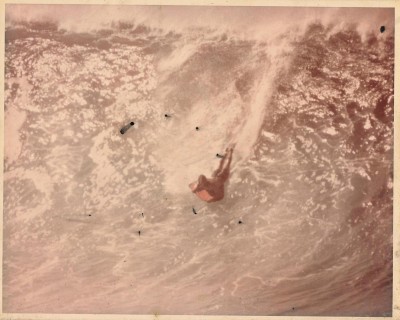
|
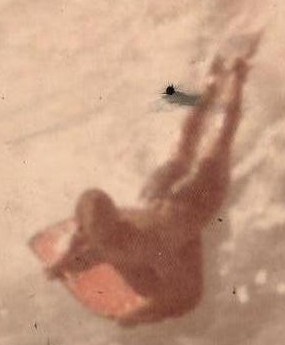
|
Photo by: Leroy Grannis
|
|
5.
Did you need a different type of board to ride Pipeline? What were the
dimensions and design features of your boards? What didn't work?
I've
always used a Paipo Nui board or the Paipo Nui shape to ride at Pipe,
and I've always liked medium sized boards, maybe about 42" long, and
not longer ones. To me the paipo board is a bodysurfing board, and I
like to ride it like I'm bodysurfing. I use my hips and my legs like a
bodysurfer.
Paipo Nui Boards - Two Different but Similiar Shapes
|
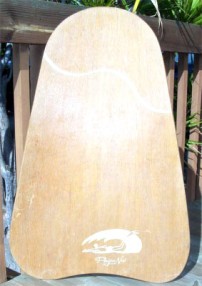
|
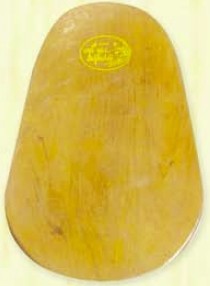
|
The
board on the right is a Paipo Nui made for Greg Noll Surf Center 40"
(1965). The auction books states, "This is one of the Val Valentine
made Paipo Nui belly boards. Deemed the “fastest craft in the water,”
this particular board was one of a limited edition made for the Greg
Noll Surf Center in Honolulu. Steam pressed rocker and extremely rare!
Includes a promotional flyer about the Paipo Nui boards."
Source: The
Auction Book from the QuikSilver Edition Hawaiian Islands Vintage Surf
Auction for 2007.
|
6. Did many guys ride paipo on the North shore?
There
weren't that many paipo riders, and I didn't hang out with any. My
peers were mostly Pipe surfers or bodysurfers and lifeguards. Andre
Vega, a friend of my brother's, rode big Waimea in the 60's. He liked
to paipo there.
7. Are there any particular surfs or waves that you rode that really stand out? Did anyone get any photos?
Over
all the years there've been so many outstanding waves and so many
barrels, it's hard to single out any one wave, but there is one that
I'll never forget. When I graduated from high school in 1973, I got a
job as a lifeguard at the Pipe. Butch Van Artsdalen was one of the
other guards there. One day in 1975, the surf was huge. The third reef
was breaking at Pipeline, at least 30' plus faces, and no one was out
anywhere. Butch and I were in the tower at Ehukai and every once in a
while we'd see a wave come in at the second reef that was a giant
makeable funnel. Butch said that he and Jose Angel used to surf it. He
told me that you had to walk down the beach to get out and then once
you were out there, line up on a yellow house. I decided to go for it,
so I walked down the beach with my paipo and fins and went out.
Riding the North Shore: Pipeline on the Blue Paipo
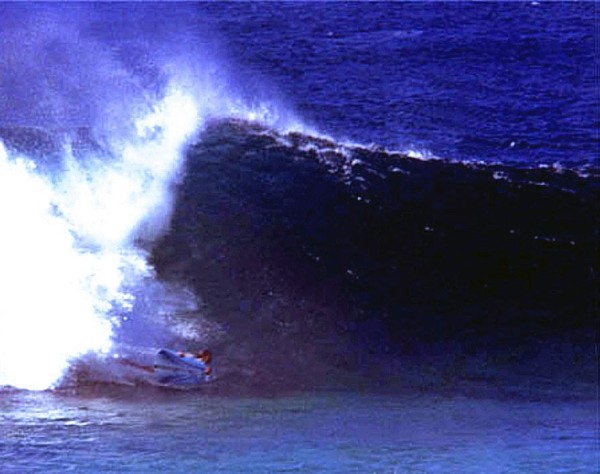
Photo by: Paul Lindbergh
I waited in the middle of these giant, out-of-control waves for an
hour, watching for that perfect second reef funnel. Then I saw a set
coming that I knew was going to do it. I watched the first wave break
so I could see exactly where to line up, and I caught the second. The
water rushing up the face of the wave was really powerful, and then all
of a sudden I was going down, down, and down. Before I knew it, the
wave was towering over me in a giant tube, and all of a sudden I was in
this tube, going the right way. I made it all the way to the beach and
ended up past the lifeguard tower.
As for photos, Steve Wilkings site has some shots of me on some good
days (see below) and Leroy Grannis took some photos on some giant days.
8. Any other favourite spots?
I
used to love Ala Moana when it was big. I love hollow waves, so when it
was really big, I'd always go out. But I live on Maui now, so I haven't
ridden Ala Moana in a long time. Two years ago I surfed Cloud Break at
Tavarua. I got the most barrelled I've ever been in my life. It was the
most perfect tube I've ever had.
Sean Ross - Ala Moana - Airborne on Month Year. Surfer Magazine photographer Steve Wilkings shot this photograph which made the centerfold
of a Surfer Annual.
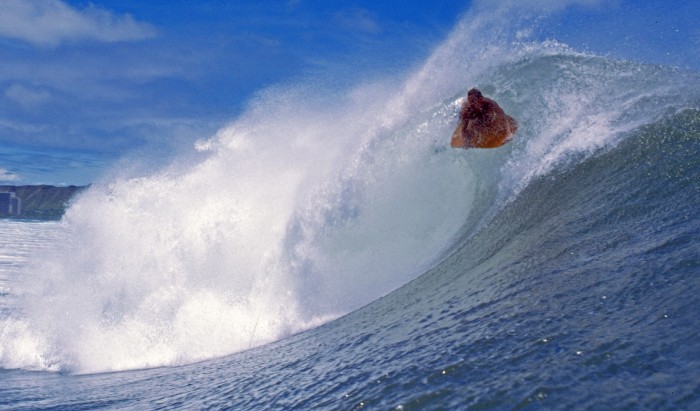
Photo courtesy of Sean Ross. Photo by Steve Wilkings, All Rights Reserved.
Tubed at G-Land (see the sequence below).

G-Land Tube Sequence (click on photo for a larger view)
Photos courtesy of Sean Ross.
9. Do you still see paipo being ridden? If so, what are your thoughts
on the way paipo are being ridden - does it differ much to how you ride
paipo?
Almost
all the guys who did ride paipo went to boogie boards when they came
out. If you were good and you wanted to compete, that's where the
action was. You can't do the tricks with a paipo, and that's probably
one of the reasons paipo riding died.
10. Do you still get out on a paipo much?
I
don't get in the water as much as I would like to, and mostly I ride on
Maui at Hookipa and Paukukalo. Surf trips seem to provide more
waves than at home. I go to Costa Rica, Indo, and Fiji. One 8'
wave at Pavonis in Costa Rica goes a long way. Cloudbreak is a great
spot, one of my longest tubes ever. I went to G-Land this year. But
it's easy to get injured, and Pipe's only a memory now. All those waves
were a combination of the era, the 70s, respect by the other guys in
the water from lifeguarding for 10 yrs, and the foolhardiness of youth.
Mentawais - October 2006
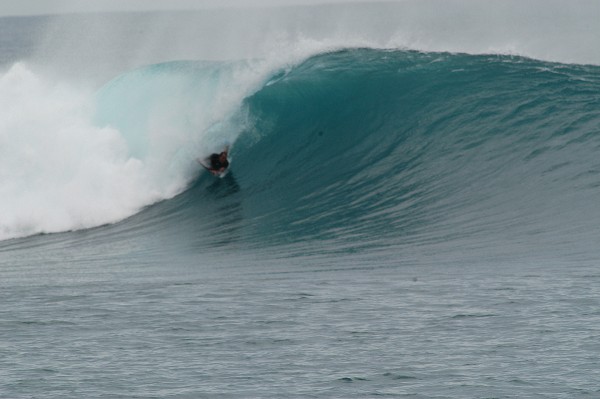
Photo by: Rob Morris, owner of the vessel "Nusantara"
11. Are there any other comments or recollections you'd like to share?
I've
learned to always bring two boards with me when I travel. When you're
surfing and you lose a board, they're hard to see. On one of my first
trips to Tavarua, I only had one board, and I lost it. We never did
find it, so now I take two boards wherever I go. I still use Duck Feet
fins.
My family had a beach house in Laie, so when we were young, we spent a
lot of time at one of those epic lefts. And I have to confess
that after riding Laie, and then Kewalo, Ala Moana, and Pipeline, I
never learned how to switch stance. So if I go right, I have to take my
right hand off the board so it does not dig in. But it sure sets up for
a nice roundhouse cutback.
|
|







